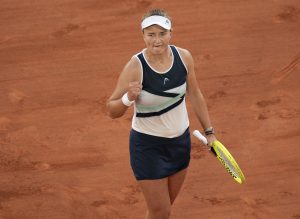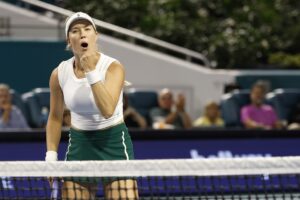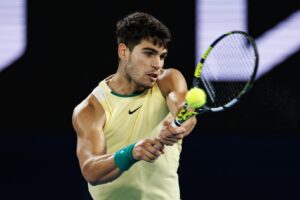In August of 2020, Aslan Karatsev broke into the top 200 at World No. 194. It had been awhile. The last time Karatsev had been a top 200 player was in March of 2016. So, what happened? And what’s changed now?
After the coronavirus hiatus in 2020, and following many exhibition matches during that hiatus, Karatsev started his second summit up the rankings towards the top of the game. And, now, Aslan Karatsev is in the main draw of a major for the first time.
But, it took many twists and turns to get to this point.
Karatsev’s story in tennis originally took an upward turn in 2013. From the latter half of May through June, the rising star Karatsev won three ITF Futures events, all on clay. The Russian only dropped one set in the three finals combined.
From there, Karatsev went on to have some earlier success on the ATP Challenger Tour. In May of 2014, he made the final of the Samarkand Challenger, losing to Farrukh Dustov. Then , in 2015, he played one more Challenger final, this time taking the title in Kazan over Konstantin Kravchuk. His ranking would rise as high as World No. 153.
In 2016, Karatsev made a couple more Challenger finals, but couldn’t lift the trophies in the end. He would hang around the top 200 for a little bit, but eventually fade back in the rankings. Karatsev wouldn’t see the final of another Challenger for years.
As the years went by, Aslan Karatsev took the familiar road from “promising young player” to “journeyman,” despite his relatively young age of 26 when the tour resumed. It’s a familiar narrative in the tennis world: if you’re not firmly planted within the top 100 by the age of 23, then we are going to forget about you and hype up the next group of young talent.
That’s not to say Karatsev’s results went down the sewer for the entirety of that 2017-2020 (pre-pandemic) period. The Russian was outside of the top 700 in the World for a period of time in 2017. As Karatsev explained to the ATP following his Challenger success in 2020, “I…had to cope with a knee injury three years ago…” Karatsev had to take several months off from professional tennis and was certainly not himself when he returned.
And while he experienced success on the Futures Tour in late 2017 and into 2018, finding his footing on the Challenger level was a longer-term struggle.
Following a Futures victory in the final week of the 2019 season, Karatsev took the momentum he had and translated it into early 2020 success. In Karatsev’s first tournament of 2020, after a string of impressive victories such as taking out Jiri Vesely, he made the final of the Bangkok Challenger before falling in a final set tiebreak to Attila Balazs.
It was a cruel match. Karatsev lost the first and third sets in tiebreaks, while winning the second 6-0.
From there, the Russian would stagnate a bit, losing four of his next six matches and getting the unlucky fortune of having the Nur-Sultan Challenger cancelled because of the coronavirus pandemic when he was in the quarterfinals.
During the pandemic hiatus, Karatsev did not sit on his laurels. He played 23 exhibition matches while the ATP Tour was not in action, winning 17 of those matches. The consistent matchplay and the feelings of victory could have only helped Karatsev get his game into gear.
Karatsev said to the ATP regarding his work during the pandemic, “…we put in a lot of work during the pandemic…I was staying home for a while and then I went to the U.S. to practise and play exhibition matches. That was good preparation. I spoke to my coach and we decided to just keep it simple.”
And, boy, did the results follow his hard work during the hiatus. Between the two Prague Challengers and the Ostrava Challenger immediately following the resumption of the ATP Tour, Karatsev had an incredible record of 15-1 in these clay court matches.
In Prague I, it took Grand Slam champion Stan Wawrinka to take him down in the final. At the Prague II Challenger, the Russian beat Tallon Griekspoor in the final. And in Ostrava, the Karatsev didn’t drop a set, including a straight sets victory over Oscar Otte to lift the trophy.
https://www.youtube.com/watch?v=8PPgzG1SzZI
This was truly an incredible run for a player that hadn’t always played tennis at such a high level with such consistency.
But, while there were other successes during the end of the 2020, including a win in the main draw of both the indoor hard ATP events in St. Petersburg and Sofia, there was one area where Karatsev fell short.
Aslan Karatsev was unable to qualify for the French Open, as he fell to Sebastian Korda in straight sets in the final round of qualifying. While this loss doesn’t look nearly as bad given Korda’s form following that match, it was yet another Major where Karatsev was unable to make the main draw.
In fact, despite making the final qualifying round for the French Open twice and the US Open once, Karatsev had never broken through to the opening round of a major.
Would the Russian be able to bring his 2020 game to 2021 and have the mental fortitude to break through at Australian Open qualifying? Or would it be yet another time he fell short?
It looked like the main draw might not be in the cards again as Karatsev got drawn against the very talented Brandon Nakashima, finding himself down a break in the third set. But, he didn’t panic and was able to break back and win the match 6-2, 6-7(4), 6-2.
And from there, Karatsev didn’t look back from there. Losing a total of six games over the past two matches, Karatsev raced past Max Purcell and Alexandre Muller to make his first Major main draw.
It was a drastic reversal of fortunes for a player who had struggled to make the Grand Slam breakthrough throughout his career.
So, what about Karatsev’s game has allowed him to impose his will on so many opponents recently?
Karatsev has a big, heavy serve that sets up points very well and allows him to take control of points during his service games early on. His forehand is heavy and is often hit deep in the court with power. His backhand is solid and the Russian also uses it to take control of points early on.
Karatsev’s shot selection is top-notch and his ability to play with controlled aggression is the best its ever been. While Karatsev’s movement isn’t a strength, he’s able to hide it well with his playing style.
And, from the looks of it, it doesn’t seem as if Karatsev’s game is going to dip any time soon. He plays a style of tennis that is going to be very tough for players to match and is able to continue his high level of play on both clay and hard courts.
And for the other players in the draw, that’s bad news.
Aslan Karatsev is not a player that they will want to see in their section of the Australian Open draw.
Main Photo:






